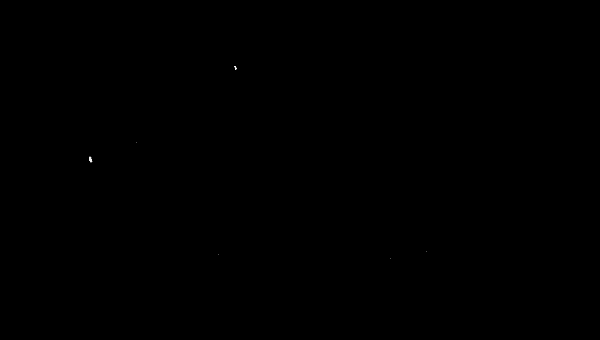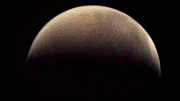Comet Siding Spring came extraordinarily close to Mars as it whizzed by on 19 October 2014. The celestial body – a mere 500 metres in diameter – passed the Red Planet at a distance of just 137 000 kilometres, where it was observed by several spacecraft in orbit around Mars. The High Resolution Stereo Camera (HRSC), operated by the German Aerospace Center (Deutsches Zentrum für Luft- und Raumfahrt; DLR) on board ESA’s Mars Express, also acquired a series of images with its SRC channel during Mars Express orbit 13710.

This animation combines multiple images that were acquired by the HRSC camera on board Mars Express during the comet Siding Spring flyby on 19 October 2014. Credit: ESA/DLR/FU Berlin
As it flew by, Siding Spring was travelling at a velocity of around 56 kilometres per second relative to Mars. Images were acquired at 17-second intervals; the spatial resolution is 17 kilometres per pixel. The images show the comet nucleus as well as the surrounding dust and gas cloud (coma).
Comet Siding Spring originates from the Oort Cloud, a comet ‘reservoir’ in the outer reaches of the Solar System. The comet was named after the Australian Observatory at which it was originally discovered back in 2013, and has the scientific designation C/2013 A1. As comets approach the Sun, one or two tails composed of gas and dust or ionised gases form on the side facing away from the Sun. As it whizzed by the planet, Siding Spring’s tail penetrated the Martian atmosphere, where it was analysed by the particle detector ASPERA-3 on board Mars Express, among others.
Scientists hope to use the data acquired, as well as the spectrometer measurements conducted at the same time, to gain an insight into the comet’s composition. It is thought that comets may contain material dating back to the formation of the Solar System.




Discussion: 8 comments
In both your and DLR’s version of the animated GIF I don’t see any greyscale, just black and white – but since the images show the inner coma (and cannot resolve the nucleus), there should be a some brightness gradient in-out, like in the HiRISE images. What happened?
Assuming the 17-seconds-interval is a constant timebase, why does the comet make so unequal jumps?
Great Update indeed.
Hopefully we get to see the SRC images too soon.
Is the bright star at the top of the frame Arcturus / Alpha Bootis? From Mars, Comet C/2013 A1 Siding Spring appeared to pass close to Arcturus.
What is it that looks like a relatively stationary object in the upper left of the image that changes in brightness between the frames? Is it some reflection on part of the orbiter, or another object in Martian orbit? A star? or something completely different?
In any case: Great pictures, great feat to have made them! Just after watching the sequence a few dozen times, it is surprising that in such a short timeframe the optical aspect of the comet’s inner coma should vary so much; you’d almost think it actually changed shape. I’m looking forward to reading how that can be explained. It seems we’re learning something new about this comet almost every day!
Daniel: From the full image sequence, can one detect rotation?
Great question for the science community! Will pass this along…
“… Comet Siding Spring originates from the Oort Cloud …” to which we should add that the existence and composition of the Oort cloud is largely conjecture, inter alia from sidings such as this one, but not an established observational fact of solar system astronomy (unless I missed some recent developments). And I just learned that coma and comet have the same etymological roots.